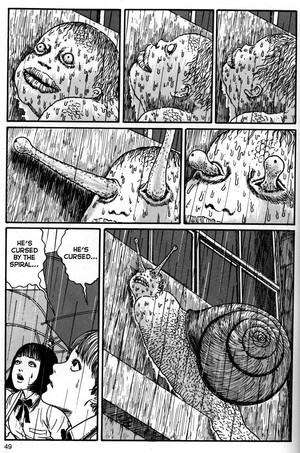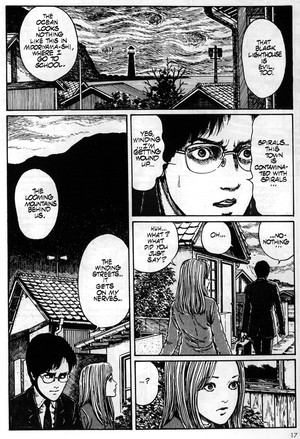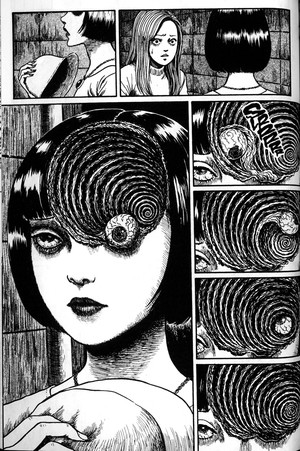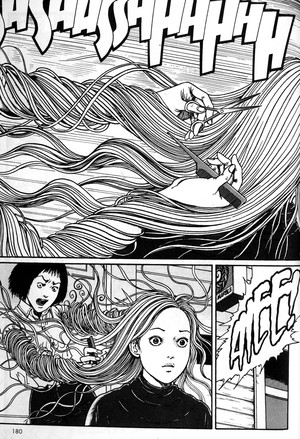Jason Thompson's House of 1000 Manga - Uzumaki
by Jason Thompson,
Episode LVII: Uzumaki
Your terrified screams are inaudible
Drowned in the spiral ahead and consumed in the shape
The spiraling shape will make you go insane
—They Might Be Giants, "Spiraling Shape"

Sometimes there's a thin line between horror and comedy. It's a cliché of the horror genre for characters to behave unrealistically; characters in movies who just won't leave the haunted house no matter how much the audience shout "GET OUT OF THE HOUSE", babysitters who go wandering off to investigate that weird noise, people who never remember to charge their cell phones. Other times horror involves the supernatural, which is inherently absurd at face value. If my friend rushed into my house telling me he was being stalked by a vampire, my first reaction would be to think it's a joke, and my second reaction would be to get really excited and start wondering about the scientific and theological implications of the existence of vampires. Some horror writers try so hard to be serious that they just make things sillier; like how in most "serious" zombie movies, the screenwriters call the zombies "things" or "the Infected," as if having the characters start saying "zombies" would make them all realize how ridiculous their situation is and they'd all have a good laugh right before the zombies burst in and ate them. The line between scary and funny often depends on your attitude; whether you're watching a horror movie in a group with friends making fun of it, or watching it alone in the dark.
Junji Ito's Uzumaki ("Whirlpool") has a concept so weird it makes fun of itself: it's the story of a town cursed by spirals and the awful things that happen to the people who live there. Drawn by Junji Ito, a horror mangaka best known for his short stories, it's one of his longest works; only his Tomie story, a loosely connected series of tales about an immortal evil girl whose severed flesh regenerates into clones of herself, is longer. It originally ran in Big Comic Spirits, a seinen manga magazine, and the English version ran in VIZ's now-extinct seinen magazine PULP, where it was the most successful title. It's a scary manga because it isn't about serial killers or monsters (although it has both of those) but about a certain nightmarish, fatalistic way of looking at the world; after all, Ito is a mangaka who can even turn a manga about his own cats (the untranslated Junji Ito's Cat Diary: Yon & Muu) into the creepiest thing you can imagine.

Kirie, the narrator, is a teenage girl who lives in a seaside town with her family. Her hometown, Kurozu-cho ("black spiral town," a name which should clue any Japanese speaker into what's coming), is a remote place surrounded by steep cliffs, where the everpresent fog often swirls into spiral shapes, and where the eerie sound of the foghorn cuts through the mists every day. Kirie's boyfriend, Shuichi, is a good-looking guy, but he's skinny and has deep dark circles under his eyes, as if he's always worried about something. (Although they're a couple, this isn't a romance manga; they're both much too well-behaved, not to mention too busy dealing with unspeakable horrors in every chapter.)
Shuichi has a family problem. As he explains to Kirie, his father has become obsessed with spirals: he has quit his job and spends his time collecting spiral objects, such as spiral-patterned fishcakes, spiral-patterned clothing, seashells, old clock springs. Shuichi thinks his father's madness is due to the town itself, maybe something about the little whirlpools in the water, the spiral ferns in the grass. "Spirals…this town is contaminated with spirals…" he mutters. In desperation, Shuichi's mother throws out his father's collection, but his obsession only gets worse. "I don't need those things anymore," he says. "You can express the spiral with your own body." His eyes start to spin around and around, independent of one another, in a spiral pattern. And then, one day, his son and wife find him in a barrel in his study…naked and dead, his eyes bulging out, his bones stretched like rubber, his entire body contorted into a giant spiral.
That's just the end of the first chapter. When Shuichi's father is cremated, the smoke rises from the kiln in an ominous spiral, which then sinks down into Dragonfly Pond, the lake at the center of town. Terrified of ending up like her husband, Shuichi's mother develops an insane spiral-phobia, to the point of slicing off her own fingertips with scissors to get rid of the spirals in her fingerprints. When Kirie's father, a potter, uses mud from Dragonfly Pond to make his pottery, the resulting pots turn out with strange spiral glazes and shapes, and what looks like distorted faces pressed into their surface. Kirie's beautiful straight hair starts to curl uncontrollably, and the hair spirals take on a life of their own. People begin to transform into giant snails, their warty bodies leaving trails of slime. Dead bodies are found near the hospital, covered with spiral-shaped wounds, their bodies drained entirely of blood. The Kurozu-cho lighthouse keeper vanishes, but the lighthouse continues to operate, bathing the town in its hypnotic, spiral light. And did you ever notice that there's a spiral right next to your brain, in your cochlea, in the inner ear…?

Amazingly, Uzumaki manages to come up with spiral-themed horror ideas for three full volumes. For the first two volumes the stories are mostly disconnected. Apart from Shuichi, Kirie and her family, almost every character dies horribly right after they're introduced, such as Azami, the girl with the spiral scar on her forehead, or Katayama, a boy who seems to be perpetually soaked with water and who starts to develop a hunchback in the shape of a snail shell. Kirie, too, often narrowly escapes dying; a few chapters even end with her first-person narration saying things like "And then I miraculously survived." Some of the spiral manifestations seem to be a little shoehorned into the idea (spiral mosquitoes? Spiral mushrooms?) but when the idea is wobbly, Junji Ito takes the advice of Stephen King: "If you can't pull off terror, go for horror. If you can't pull off horror, go for the gross-out." In true horror story fashion, Kirie's family is stubbornly resistant to moving out of Kurozu-cho despite the obviously horrible things happening there; the whole time, you want to shout at them "GET OUT OF THE TOWN!" Or, in one chapter, "WHY ARE YOU GOING TO THE GRAVEYARD IN THE DEAD OF NIGHT TO DIG UP A DEAD BODY?"
But despite these few flaws, my sheer curiosity to know what would happen next kept me reading all the way into volume three, where suddenly, a plot develops. In volume three, Kurozu-cho is devastated by a hurricane (spiral: check), and the survivors find themselves trapped in the ruins by space-time distortions, unable to leave. Suddenly, things are serious. Shuichi, Kirie and a TV reporter try desperately to escape the spiral, although rescue teams and even the Japanese navy can't get them out. Madness and mutation takes its toll, and there are "Aha" moments as we realize that Ito wasn't just making it all up as he went along. And finally, Ito shows us what lies at the spiral's heart…
I edited the VIZ edition of Uzumaki, and it's one of my favorite manga I've worked on. It's got scenes of gross-out horror, but mostly it's creepy, not terrifying; a slow, almost leisurely descent into inevitable doom. Sure, the characters are ciphers, but who cares; we can easily imagine that we might be those ciphers, trapped in Kurozu-cho, running from spirals. And if some of the Uzumaki stories read like jokes, the punchlines are the scariest, grossest sight gags you've ever seen. When the climax of each story comes, and Kirie or Shuichi sees something awful, the manga becomes almost like a story told from first-person POV: closeup after closeup, as the horror becomes closer and more detailed, often with a side view of Kirie's face as she, like us, stares helplessly. You can see the same effect in the work of Kazuo Umezu and Hirohiko Araki; that long horror-stare that makes you feel like something might jump right out of the page and attack you, maybe even go for your eyes. (There's also a lot of moments in the script when characters command the reader to look:"Look! Look what's happening!" "Look at that!" "Take a good look!")

Uzumaki's originality is one of its strong points, but the satisfying-but-cryptic ending of the story left me restless, wondering what Ito's influences might have been. Junji Ito has admitted being a fan of H.P. Lovecraft, whose obsessions with madness, slimy tentacled things and weird geometric patterns (like the "non-Euclidean" geometry in the monster-god Cthulhu's lair in the sunken city of R'lyeh) seem like an influence on Uzumaki. The series also makes me think of the British horror writer Ramsey Campbell, whose stories, particularly the novel Midnight Sun, often involve some kind of pattern or shape which conceals a malevolent intelligence. The fear of transforming into something inhuman, of having your body stretched and mutilated, is a horror trope that appears in other Ito stories like the meme-generating The Enigma of Amigara Fault. There's just a tiny sexual element to some of the Uzumaki stories as well, like the story about the voyeur who peeks on Kirie through the walls of her house, and the spiral-shaped swellings that grow out of his body…or the surprise ending to the story of the snails…
A transformation of the body is even worse when it includes a transformation of the mind, so that you want to change. Inexplicable group madness…a simple shift of the brain that causes civilization to collapse and humans to turn into monsters…these are the kind of nightmares that appear in the work of Shintaro Kago, whose work, like Uzumaki, often starts with some innocuous theme (say, baseball or sumo) and takes the obsession to the most horrifying, disgusting extreme. Similarly, Koji Kumeta's Sayonara, Zetsubou-sensei could be a horror manga if you look at it the right way. Uzumaki, although not as X-rated as Kago's work or as cute as Kumeta's, exists on that same borderline between humor and the grotesquely nasty. You'd want to laugh, if your throat weren't clogged up by the swollen, spiral-shaped tongue emerging from your mouth.
Uzumaki is probably the most famous horror manga translated into English, not counting action horror like Hellsing and Berserk. It deserves to be famous. If you like it, you may also want to netflix the 2000 Japanese live-action movie adaptation directed by Higuchinsky. It's an amazingly weird, creepy, high-energy film which manages to compress most of the plot of the manga into 90 minutes, and even has decent special effects. Unsettling details are scattered throughout the movie like Easter eggs, making it worth watching more than once, and the ending, while abrupt and different from the manga's ending, is darkly elegant in its own way. It's also a bit more romantic than the manga, focusing more on the relationship between Shuichi and Kirie, those good-hearted but oblivious teen lovers who just can't seem to escape the spiral closing in around them. The movie is a love story from the very beginning; the manga turns into a love story at the end. Maybe love is something that defends us from the horror, or maybe it's just another way of looking at the same thing. Watch it in the dark with someone you love.
Jason Thompson is the author of Manga: The Complete Guide and King of RPGs, as well as manga editor for Otaku USA magazine.
Banner designed by Lanny Liu.
discuss this in the forum (21 posts) |